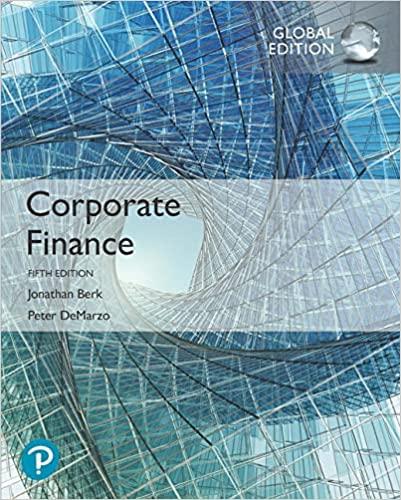Question
Quantitative Problem: Barton Industries expects that its target capital structure for raising funds in the future for its capital budget will consist of 40% debt,
Quantitative Problem: Barton Industries expects that its target capital structure for raising funds in the future for its capital budget will consist of 40% debt, 5% preferred stock, and 55% common equity. Note that the firm's marginal tax rate is 40%. Assume that the firm's cost of debt, rd, is 8.2%, the firm's cost of preferred stock, rp, is 7.7% and the firm's cost of equity is 12.2% for old equity, rs, and 12.6% for new equity, re. What is the firm's weighted average cost of capital (WACC1) if it uses retained earnings as its source of common equity? Round your answer to 3 decimal places. Do not round Intermediate calculations.
___%
What is the firms weighted average cost of capital (WACC2) if it has to issue new common stock? Round your answer to 3 decimal places. Do not round Intermediate calculations. ____%
The difference between the flotation-adjusted cost of equity and the cost of equity calculated without the flotation adjustment represents the flotation cost adjustment.
Quantitative Problem: Barton Industries expects next year's annual dividend, D1, to be $2.10 and it expects dividends to grow at a constant rate g = 4.3%. The firm's current common stock price, P0, is $23.60. If it needs to issue new common stock, the firm will encounter a 5.6% flotation cost, F. Assume that the cost of equity calculated without the flotation adjustment is 12% and the cost of old common equity is 11.5%. What is the flotation cost adjustment that must be added to its cost of retained earnings? Round your answer to 2 decimal places. Do not round intermediate calculations. %
What is the cost of new common equity considering the estimate made from the three estimation methodologies? Round your answer to 2 decimal places. Do not round intermediate calculations. ____%
Quantitative Problem: Barton Industries estimates its cost of common equity by using three approaches: the CAPM, the bond-yield-plus-risk-premium approach, and the DCF model. Barton expects next year's annual dividend, D1, to be $1.50 and it expects dividends to grow at a constant rate g = 4.7%. The firm's current common stock price, P0, is $30.00. The current risk-free rate, rRF, = 4.6%; the market risk premium, RPM, = 5.9%, and the firm's stock has a current beta, b, = 1.1. Assume that the firm's cost of debt, rd, is 6.5%. The firm uses a 3.9% risk premium when arriving at a ballpark estimate of its cost of equity using the bond-yield-plus-risk-premium approach. What is the firm's cost of equity using each of these three approaches? Round your answers to 2 decimal places.
| CAPM cost of equity: | % |
| Bond yield plus risk premium: | % |
| DCF cost of equity: | % |
What is your best estimate of the firm's cost of equity?
Quantitative Problem: Barton Industries can issue perpetual preferred stock at a price of $59 per share. The stock would pay a constant annual dividend of $2.60 per share. If the firm's marginal tax rate is 40%, what is the company's cost of preferred stock? Round your answer to 2 decimal places. %
Step by Step Solution
There are 3 Steps involved in it
Step: 1

Get Instant Access with AI-Powered Solutions
See step-by-step solutions with expert insights and AI powered tools for academic success
Step: 2

Step: 3

Ace Your Homework with AI
Get the answers you need in no time with our AI-driven, step-by-step assistance
Get Started


